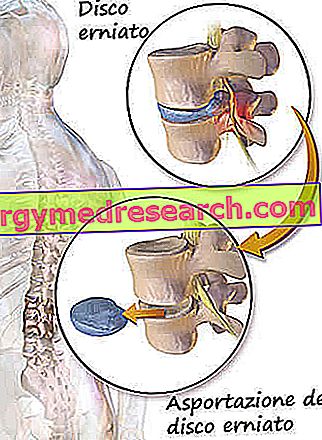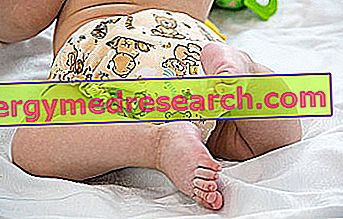Generality
Discectomy is a surgical option used in case of a herniated disc . This approach consists in removing more or less abundant portions of the damaged intervertebral disc, after having removed the hernia that originated from it.

Discectomy is generally indicated when patients are refractory to conservative treatments (drugs and / or physical therapy) or when symptoms (back pain, loss of sensitivity, difficulty in walking, etc.) are increasingly serious.
From a practical point of view, the surgeon proceeds in general anesthesia to remove the herniated disk fragment, using more or less invasive techniques, in order to allow the patient a rapid functional recovery .
Should it be necessary to remove most of the nucleus pulposus, a prosthesis (or a spacer made of synthetic or autologous bone) is associated with the discectomy between the two vertebrae involved.
Slipped disc
Definition
The herniated disc is a rather frequent spinal column disease, which can also affect young people. The age group most affected is that between 30-50 years old.
The pathology is the result of the leakage, from its natural site, of the pulpous nucleus contained within the intervertebral disc ; the latter represents the fibrocartilaginous junction situated between one vertebra and the other, and has the function of absorbing and uniformly distributing the received solicitations, acting as a sort of "shock absorber" .
The nucleus pulposus consists of spongy tissue, is located at the center of the intervertebral disc and is held in place by a cartilage shell ( fibrous ring ). The role of the latter is to keep the intervertebral disc anchored to its two vertebrae.
The fibrous ring can deform under the elastic thrust of the nucleus pulposus ( hernia contained ) or break, causing the nucleus to escape ( expelled hernia ) and invading an irrelevant space in the vertebral canal ( hernia migrata ). In these cases, the nucleus pulposus comes into contact, therefore, with the nerve roots, irritating them physically and chemically; this triggers the symptoms typically associated with a herniated disc.
Causes
The herniated disc is the consequence of particular stresses that come to wear the fibrous ring placed to protect the nucleus pulposus. Sometimes, the intervertebral discs exceed the limits of elasticity due to physically demanding jobs or important traumas, which the spinal column undergoes during sports, following a weight lifting or due to the habit of incorrect positions.
The disorder can also be the direct consequence of deterioration phenomena associated with the aging of the osteoarticular structures of the spine. The herniated disc mainly affects the cervical, dorsal and lumbo-sacral portions of the spine.
Signs and symptoms
The herniated disc can be highly debilitating: the escape of the nucleus pulposus of an intervertebral disc with a fibrous ring can compress the nerve roots that exit from the vertebral canal, causing a very strong pain that can also limit normal movements. These symptoms can affect the neck or back, or they can radiate to the arms or legs. At a first stage characterized by signs of irritation of the nervous structures, sensory and motor deficits take over. Numbness or weakness, motor difficulty, loss of muscle strength, numbness and tingling of the limbs may occur.
Diagnosis and treatment
In addition to a medical examination, radiographs and magnetic resonance imaging or CT scan of the spine are required. In most cases, it is sufficient to resort to conservative treatment (rest, physiotherapy and drugs). However, if the hernia causes increasingly severe neurological and motor disorders, and such as to compromise the performance of daily activities, surgery may be indicated.
What's this?
Discectomy is a surgical procedure used to remove the damaged part of an intervertebral disc affected by a herniated disc. This option is especially indicated when a significant loss of strength occurs or when, despite medication and physiotherapy, the pain increases.
How do you do it?
The two most common methods of intervention in the event of a herniated disc are traditional and endoscopic microdiscectomy.
- Traditional microdiscectomy : it is a percutaneous technique that guarantees good results. In practice, it consists in the removal of the herniated material and the disc from which it comes, through a median posterior penetration, through the vertebral canal. The technique is completely analogous to the standard discectomy, but it allows to greatly limit the size of the incision and of the intervention field, and requires the use of the operating microscope.
- Endoscopic microdiscectomy : it uses the endoscope, an instrument consisting of a very small flexible tube, in turn formed by a series of very thin optical fibers, connected to a micro-camera. After making an incision of a few millimeters, the endoscope is inserted by lateral penetration of the disc into the area to be treated. It is precisely through these miniaturized instruments that the surgeon removes the hernia.
Both of these procedures are performed under general or spinal anesthesia . In any case, the goal is to limit the impact on the anatomical structures that must be crossed to get to the herniated disk as much as possible.
The standard discectomy consists, instead, in removing the pulpy nucleus with a classic open-top surgery (total or partial), using optical magnification tools.
- At the lumbar level, this treatment involves opening a small bone door to access the back of the vertebral canal ( laminectomy ) and remove the herniated fragment.
- On the cervical level, however, the herniated disk is reached through a small incision in a fold of the neck, then it is completely removed, removing the hernia and releasing the trapped nerve root, which causes pain.
At the end of the procedure, the injured intervertebral disc is replaced with the implantation of a metal or ceramic prosthesis ( plastics ), with the patient's synthetic bone (usually taken from the hip) or coming from a donor or an animal.
Sometimes a vertebral stabilization or fusion with screws and plates may be necessary.
Other techniques available are:
- Laser discectomy : uses a laser beam applied directly to the disc's nucleus, which vaporizes the hernia through special cannulas. The procedure can be performed under radiological control and through the percutaneous approach. This technique can be difficult for the treatment of herniated discs at the low back level.
- Disc coblation : this non-invasive procedure consists of the introduction into the disc space, under radiological control, of a needle to which an electrode is applied. The latter through the transmission of high frequency energy (radiofrequency) is able to dehydrate part of the nucleus pulposus. As a result, the "shrinking" disk no longer compresses the nerves, so the pain disappears and the mobility improves. This type of treatment is indicated in the early stages of the hernia.
When is it indicated?
A discectomy is generally performed in the case where a herniated disc goes to compress the spinal cord or the nerve roots, so as to produce a painful symptomatology or a progressive worsening of the clinical picture, despite the adhesion to a rehabilitation path adapted to the patient .
The purpose of the discectomy is also to limit as much as possible the onset of a relapse, therefore it provides for the thorough cleaning of the vertebral disc from which the hernia originated.
Your doctor may recommend discectomy in the following cases:
- The patient has problems walking or standing due to muscle weakness;
- Conservative treatment, such as medication or physiotherapy, fails to improve symptoms after six weeks;
- A fragment of pulp nucleus protrudes from the intervertebral disk compressing a nerve in the spinal canal;
- The pain radiating from the buttocks to the legs, to the arms or to the chest is too intense to be tolerated.
Risks of the surgical procedure
Discectomy is considered a medium-risk procedure for complications.
The potential risks of the intervention include:
- Hemorrhage;
- Infection;
- Loss of cerebrospinal fluid;
- Injury of one of the nerves or spinal cord;
- Injuries to blood vessels in and around the spine.
Benefits
Discectomy reduces the symptoms of disc herniation in most people who have obvious signs of compression of a spinal nerve (the main indication for surgery), as well as irradiation of pain.
After the surgery
Discectomy has a duration that varies from 30 to 150 minutes. The patient can get out of bed the day after surgery and is usually discharged two days later.
Post-operative pain is present for a few days, but is usually tolerable. Very important is the support of a targeted rehabilitation therapy, which allows the complete functional recovery of the patient (which generally takes place between two and six weeks after the operation, depending on the work activity or daily life carried out).
After the discectomy it is important that the person tries to resolve the causes that led to the formation of the hernia: whatever the treatment was, recurrence is possible. Some types of workers, for example, are more at risk because of posture defects deriving precisely from the profession (such as masons, drivers, employees, etc.). Therefore, it is important to limit activities that involve lifting, flexing or bending the back for at least four weeks after the discectomy.
A physiotherapist can set up a prevention and maintenance program based on regular physical activity that involves the correct use of the back. Furthermore, it would be better to avoid leading a completely sedentary life and try not to gain weight: the combination of these factors weighs on the spine and, consequently, on the intervertebral discs.
Results of the intervention
The success rate of the operation, understood as the resolution of the pain caused by the compression of a nerve root, approaches 95%.
However, discectomy cannot be considered a permanent cure, as it does nothing to reverse the process that led to the formation of the herniated disc. In fact, after the operation there is a possibility of recurrence.
To avoid damaging your spine again, your doctor may advise you to lose weight or start a low-impact exercise program. It may also be required to limit certain activities that involve a repetitive series of pushups, twists or lifts.



